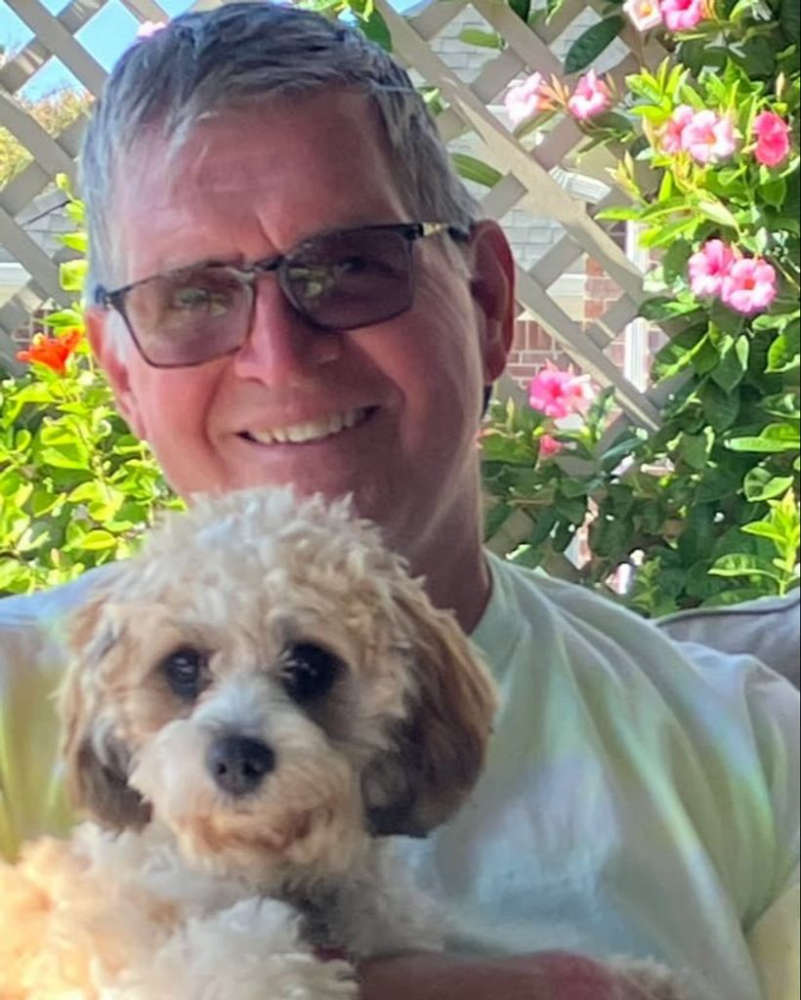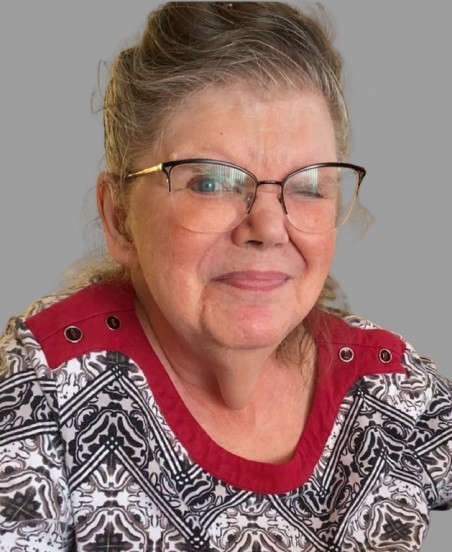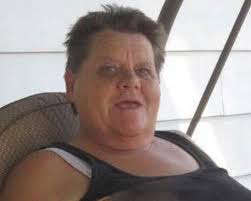
Over the years, beginning in the early 1980s, I have visited Hiroshima on numerous occasions. I always make it a point to visit not only the Hiroshima Peace Memorial which includes the Atomic Bomb Dome (Genbaku Dome in Japanese) (main photo) and Hiroshima Peace Memorial Museum, but also the surrounding area that includes the Children’s Peace Monument, Hiroshima Victims Memorial Cenotaph, Bell of Peace, Atomic Memorial Mound, and the Flame of Peace, all located within the area of the Hiroshima Peace Memorial Park.
Each time I visit the museum, I am invariably moved emotionally as I walk through the solemn and subdued exhibits reverently, reflecting on what occurred on Aug. 6, 1945, when the U.S. dropped the first atomic bomb called “Little Boy” on the city, and how the lives of all those people were affected then and still today, as subsequent generations have had to deal with the physical effects of the atomic bomb.
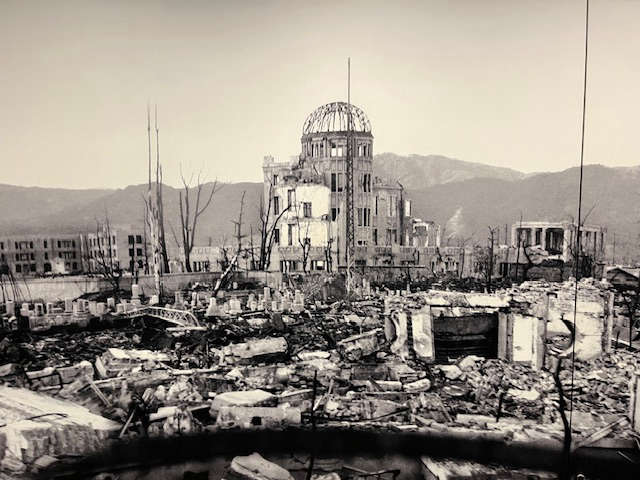
It has been estimated that there were between 70,000 and 80,000 immediate deaths, and by the end of 1945 around 140,000 due to the effects of radiation poisoning. Around 90% of the city was completely destroyed with extensive damage to buildings and infrastructure. (photo) The survivors, called “hibakusha” in Japanese, endured long-term health issues, including cancers and chronic illnesses due to radiation exposure.
Unlike some of the other places I have introduced in this column in recent months, Hiroshima is not “off the beaten path” by any stretch of the imagination. It is a huge tourist spot for people from all over the world even though, being much further south than the other big tourist spots in Japan, people have to make a conscious effort to visit there. They do so because of its importance in modern history.

It seems to me that the city warmly welcomes all the domestic and international tourists who flock there because it is one way to continue to get its message of nuclear non-proliferation and world peace spread far and wide. Each new generation that visits this sacred place leaves there with a deeper understanding of what happened on that fateful day and why it cannot be allowed to be forgotten or to ever occur again anywhere in the world.
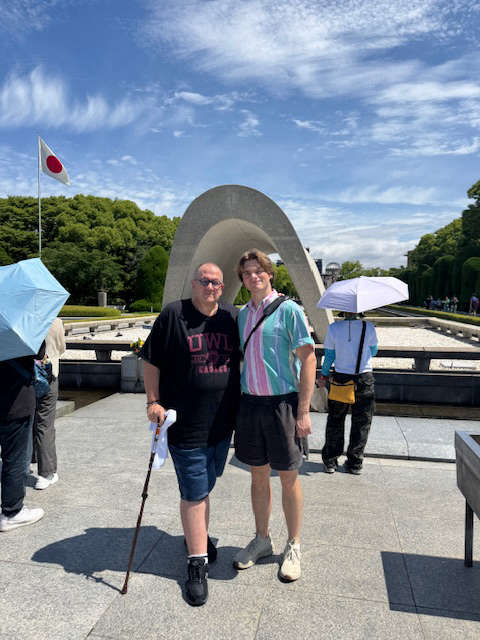
On this particular visit, I wanted to show it to a very special young man, Dawson Davis (photo, right), who is visiting Japan from Indiana for the first time, and who is very much like a nephew to me. His mother and I were besties in high school, and I have watched him grow up to become a well-rounded, mature, open-minded, resilient, and adventurous young man who is genuinely interested and socially aware of all that life, society, and culture have to offer. In fact, he calls me “Uncle Todd.”
In many ways, he reminds me of myself because he loves to travel the world, and he has a deep appreciation for the study of history. In his young life he has lived in Germany, Ireland, Uganda, and now Japan, and has an innate curiosity and tries to absorb as much knowledge as he possibly can about the places where he lives and visits.
While we are not blood-related, he and his family are as close to any “blood relation” that I have. Also, because he is a student of history, like me, I knew he would appreciate the experience of visiting Hiroshima, and the visit would have a profound impact upon him intellectually and academically, as well as emotionally and personally.

Truthfully, I can’t imagine any person ever exiting the museum and Peace Memorial Park without having some sort of visceral reaction to what they just experienced and viewed. Unlike many places people visit on vacations, Hiroshima isn’t fun and cheerful in an entertaining sort of way, but it is impactful. The experience, however, does stay with you long after you board the train or plane to leave or fly back from whence you came.

And it is for this reason that I always advise people to put Hiroshima on their itinerary of must-see places in Japan. Since I live just about 90 minutes from Hiroshima by bullet train, we visited it as a day trip. We got up early, boarded two different trains and arrived in Hiroshima by 9:30 a.m. We immediately headed for the Atomic Bomb Dome Memorial, hoping to miss the crowds that no doubt would be arriving soon after, which was a smart choice.
We were able to walk the perimeter of the memorial slowly and deliberately to take it all in. It has been thoughtfully preserved as a physical and tangible representation of the epicenter of the explosion. The bomb exploded about 600 meters directly above the building, which is why it was partly left intact, unlike everything else that was demolished on all sides for as far as the eye could see.
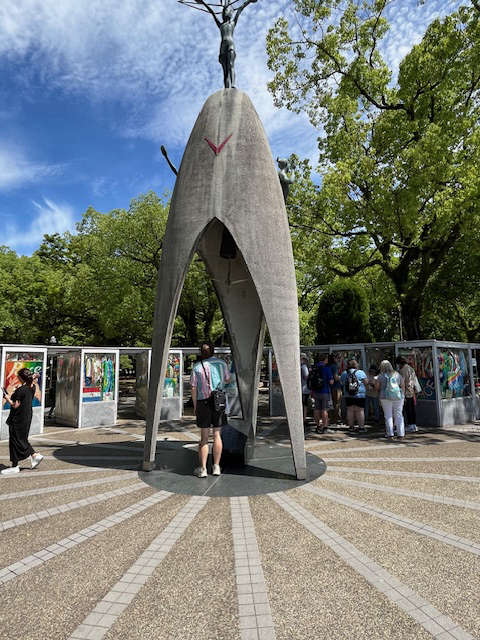
After crossing the river, visitors are almost immediately in the Peace Memorial Park area that takes visitors towards the museum. Along the way, there are a number of other displays that are tastefully represented as memorials. The Children’s Peace Monument (photo) is especially moving because it commemorates Sadako-chan and all child victims of the bombing.
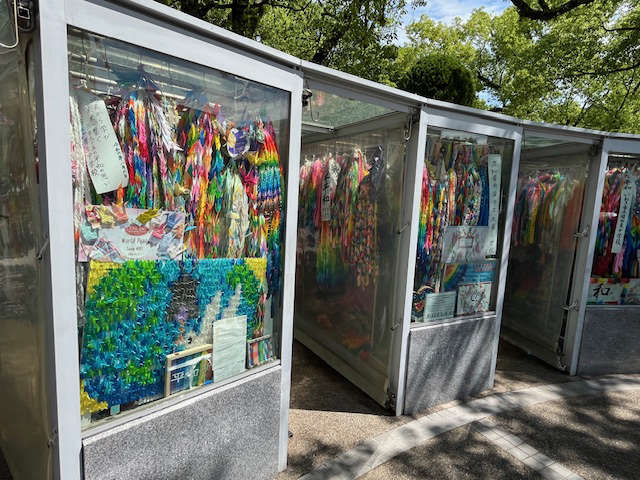
Sadako was two years old when the bomb was dropped, but by the age of 12, she had developed leukemia — directly related to radiation exposure. She began folding origami cranes in hopes of folding 1,000, which she believed would grant her a wish. This Japanese custom of folding cranes is often done to wish for good health and/or peace. Sadly, she only made 644 by the time she passed away in 1955.

Her story of perseverance and determination in the face of such hardship has become a symbol of the horrors of nuclear war and her story represents a call for peace. I think she could be regarded as a sort of Japanese Anne Frank, in that her life story is included in numerous textbooks for children, and her ordeal is widely written about in books.
While a visit to the Hiroshima Atomic Bomb Dome Memorial, Peace Memorial Park, and Hiroshima Peace Memorial Museum are not necessarily uplifting, it is inspiring and deeply thought provoking.
So, if you are planning a trip to Japan, I highly recommend you visit Hiroshima to experience all of this for yourself.




